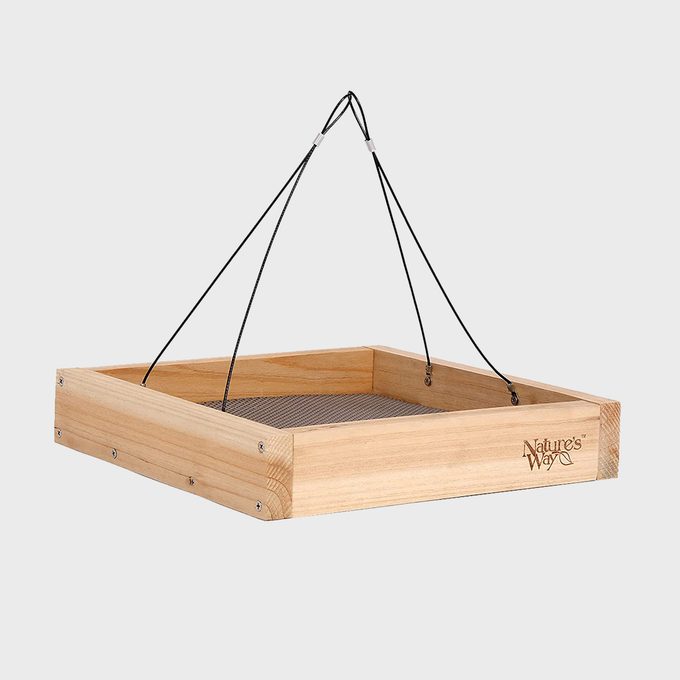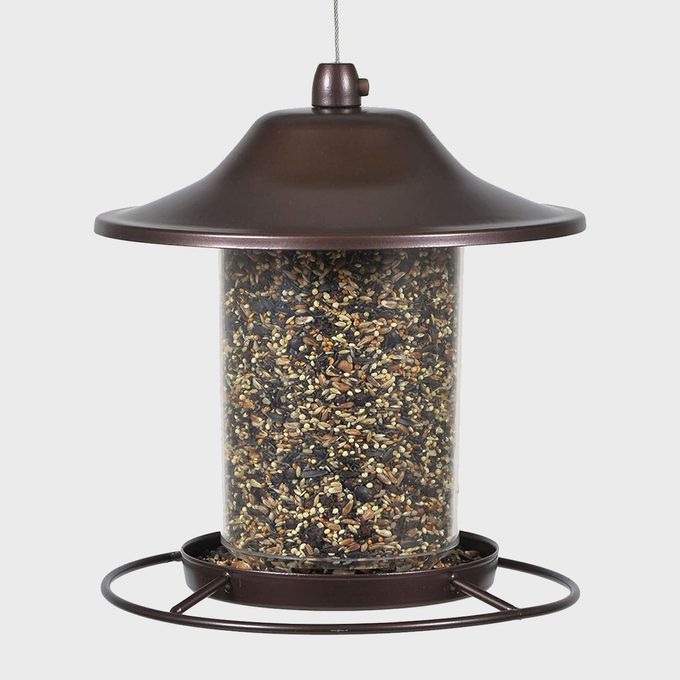On crisp, winter mornings, it can be difficult to sleep in at my house with all the noise from the birds around my feeders. From the tweets and twitters of timid chickadees to the rambunctious yaks of Stellar’s jays, there’s never a dull bird-watching moment.
If you’re having trouble waking up in the morning, getting a bird feeder is a great remedy. Here’s how to choose a good one.
What Is a Sunflower Seed Feeder?
Sunflowers can be served up in any kind of feeder, as long as the openings are large enough for birds to access the seeds.
Sometimes when people talk about “sunflower seed feeders,” they’re referring to tube feeders, sometimes called exclusion feeders. Those are popular among people seeking to attract songbirds while deterring squirrels and large birds.
Types of Sunflower Seed Feeders
The three main types of sunflower seed feeders are:
- Tube feeders;
- Tray feeders;
- Hoppers.
Tube feeders allow only smaller birds to feed. Their small perches, plus fencing or weight mechanisms, make it difficult for squirrels and large birds to get at the seed. Their roof and sides also protect the food inside from the elements.
Tray feeders are more versatile because they accommodate more kinds of food, thus luring a wider variety of birds. “They are also more visible to the birds, helping birds find food faster,” says Brian Cunningham, product and hobby education manager for Wild Birds Unlimited.
Unless the feeder has a roof, the seed is exposed to the elements. That’s usually fine as long as the feeder has good drainage. And tray feeders don’t have to be formal. Emma Greig, project leader at the Cornell Lab of Ornithology’s Project FeederWatch, says “even an old stump can be a platform feeder.”
Hopper feeders, which resemble little houses with a platform underneath, also offer a good perching area for lots of birds. They’re nice because they can hold a lot of seed, and their roofs protect the seed from the elements.
If you’re looking to attract specific birds, this tool from FeederWatch will tell you what kind of food and feeders each breed likes best. And this resource offers more information on feeding birds.
How To Keep Birds Safe With Feeders
Feeding birds can save their lives during food shortages, as well as balance out habitat lost to development. But it can also be harmful if you don’t clean the bird feeders regularly.
“Not cleaning things, not changing their seed out, those are two very big dangers,” says Zach Hutchinson, community science coordinator for Audubon Rockies. “If your seed gets wet, it can mold quickly, and then you’re talking fungal issues.”
Hutchinson says feeders and water sources ideally should be cleaned once a week, but at least once a month. “You don’t want to go longer than that,” he says. “Bacteria growth does not need a month to happen. The spread of a virus does not need a month to happen.”
If you see birds with tumors or swollen eyes, or if they appear lethargic and exhibit unusual behavior, those could be signs of disease. In those cases, take the feeders down for a while and clean them. Check with local agencies or bird nonprofits to see when the threat of area disease has passed, and when it’s safe to put the feeders back up.
You can also check seed freshness by doing a “paper test.” Cunningham says to press a shell-less seed onto a piece of paper and observe how much oil stains it. “No stain? The sunflower has dried out and is not desirable to the birds,” Cunningham says. “A big oil stain? This is fresh seed.”
Also, if you’re using shell-less seeds, only fill the feeder with enough to last a few days. This is especially important when it’s wet or humid.
How To Make a Sunflower Seed Feeder
Building a feeder doesn’t need to be complicated. “You can make your own platform feeder with an old piece of window screen and a piece of wood,” Greig says
For a more elegant solution, let nature make it for you. If you’ve grown sunflowers, turn your dried sunflower heads into feeders.
- When a flower head starts to droop, cut it off.
- Poke a hole all the way through the middle of the flower.
- Thread a piece of string through the hole and tie the ends together.
- Hang it somewhere where the birds will feel safe eating from it and where you also have a good view.
How To Choose a Sunflower Seed Feeder
Whether you go tube, tray or hopper, Cunningham recommends taking a few features into consideration when purchasing a sunflower seed feeder. A good feeder will:
- Be aesthetically pleasing;
- Allow views of the birds on most if not all perching areas;
- Be easy to fill, even when wearing gloves;
- Be easy to clean;
- Be easy to see the food levels;
- Protect the food from the weather;
- Offer good water drainage;
- Withstand a tumble as well as harsh weather;
- Allow birds to comfortably perch and feed,
- Be easy to hang or mount;
- Prevent birds from getting their heads or feet caught in openings;
- Make seed easy to reach.
Top-Rated Sunflower Seed Feeders
From complex squirrel-proof feeders to simple wooden boxes, feeders vary. Most work just fine, so in the end it comes down to personal preference. Here are a few favorites:
Best Affordable Tray Feeder: Nature’s Way Cedar Platform

Natural wood always looks at home in the outdoors, and the cedar on this feeder helps keep the bugs and mold at bay. This one is large enough that most birds feel comfortable stopping by for a snack. The tray also lifts out for easy cleaning.
Best Tube Feeder: Wild Birds Unlimited’s EcoClean Medium Seed Tube Feeder

One nice feature of this tube: Their EcoClean technology minimizes bacteria, mold and other microbes. It also has some cool details, like powder-coated perches and a bottom that’s easy to remove and clean. It comes with a lifetime guarantee that covers squirrel damage.
Best Basic Feeder: Perky-Pet Two-Pound Feeder

This feeder is popular because of its elegant aesthetics and affordable price. The circular perch makes bird watching easy from any angle. The simple design and large opening means it’s easy to fill and clean.
How Else Can I Help Birds in Winter?
Besides keeping the feeders clean, Hutchinson and Greig recommend helping out birds during the winter by:
- Creating brush piles and other habitat for foraging and shelter;
- Leaving native plants standing over the winter;
- Providing fresh, clean water.
- Keeping cats indoors;
- Refraining from pesticide use;
- Cutting back other chemicals used in your home.
Hutchinson says Audubon encourages homeowners to convert non-native yards of turf grass back to native plants.
“The problem with just [feeding birds] seeds is, during the summer months a large percentage of birds’ diets are made up of arthropods, which are crucial for their chicks’ feather and bone development,” Hutchinson says.
“Native plants support arthropods and other insects, plus can provide an additional food source if they’re also fruit and seed bearing. So our big push is for native habitat in your yard. Can you supplement that with birdseed? Yes, absolutely.”
Article source here: What To Know About Sunflower Seed Feeders


No comments:
Post a Comment